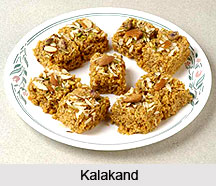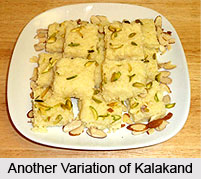 Kalakand is a traditional recipe of India. The sweet is very healthy as it is loaded with calcium and protein. Kalakand is very tasty and is easy to prepare.
Kalakand is a traditional recipe of India. The sweet is very healthy as it is loaded with calcium and protein. Kalakand is very tasty and is easy to prepare.
Ingredients of Kalakand
•2 litres milk
•1/2 to 3/4 cup sugar
•Chopped nuts to decorate (pista, almonds)
•Silver foil (optional)
•1/2 tsp citric acid dissolved in 1/2 cup water
Method of Preparing Kalakand
•Boil half the milk and add the citric solution as it comes to boil. Switch off gas.
•Once the chenna settles sieve through muslin cloth, press out excess water, take in a plate and press down. Do not knead.
•Put the remaining milk in a heavy pan and boil to half.
•Add the chenna and boil till the mixture thickens, stirring continuously.
•Add the sugar and continue to cook, stirring all the while till softly thickens in a lump.
•Set in a tray, apply silver foil and sprinkle the chopped nuts.
•Serve.
Another method of preparing Kalakand with slight change in the ingredients:
Ingredients of Kalakand
•8 cups or 2 quart milk
•1/2 cup sugar
•2 to 3 tablespoons lemon juice (for making paneer)
•1 tablespoon sliced almonds or pistachio for garnishing
 Method of Making Paneer:
Method of Making Paneer:
•Mix lemon juice in ¼ cup of hot water and put aside.
•Boil the 4 cups of milk in a heavy bottomed pan over medium heat, stirring occasionally, making sure not to burn milk.
•As the milk comes to a boil, add the lemon juice gradually and stir the milk gently. The curd will start separating from the whey, turn off the heat.
•Once the milk fat has separated from the whey, drain the whey using a strainer line with cheesecloth, or muslin cloth.
•Wrap the curds in a muslin cloth, rinse under cold water, and squeeze well. This process takes out the sourness from the lemon.
•To take out the excess water, squeeze the wrapped paneer. Do not knead the paneer.
Making Kalakand:
•Boil remaining 4 cup of the milk in a heavy bottom frying pan on medium high heat until the milk reduces to about two cups.
•Make sure to frequently stir the milk.
•Add the paneer in the milk and keep stirring till the mixture thickness and form a soft dough consistency.
•Add the sugar and continue to cook and stirring until the mixture become soft lump and start leaving the pan from sides.
•Pour it over greased plate keeping about half inch thick.
•Let it cool for about one hour.
•Cut the kalakand in squares.
•Serve.
This mouth-watering dish can be served to the guests during various occasions and celebrations like Diwali, Rakhi, birthday party etc.




















